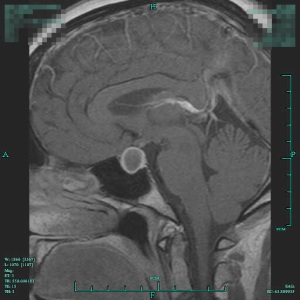“Hyperprolactinemia” refers to an abnormal elevation in serum prolactin levels. We see many cases a year of this associated with infertility. It is a highly treatable condition and one that can also be a serious health risk. The signs of hyperprolactinemia are infertility, irregular menstrual cycles, milky discharge from the breast, headache and sometimes changes in vision. In some cases of severe hyperproctinemia, the estrogen level can be decreased to a point where loss of bone calcium can occur.
Causes of elevated prolactin include:
- Prolactin secreting tumors (adenomas) are the most common cause
- Non-prolactin secreting tumors can cause mild elevations in prolactin if large enough
- Hyperinsulinemia is associated with elevated prolactin
- Breast augmentation (implants) or other chest wall surgeries can stimulate prolactin production
- Pregnancy is a cause of prolactin elevation and should always be ruled out first
- Hypothyroidism can be associated with a rise in prolactin
Treatment of hyperprolactinemia includes medical and possible surgical treatment. The vast majority of cases can be treated medically using a drug that functions to bring the prolactin level down (dopamine agonist therapy). The two most common medications used are parlodil (bromocriptine) and dostinex (carbergoline). These medications are usually well tolerated. The former is used every day the the latter is used twice a week. Treatment usually continues up until pregnancy occurs and is then discontinued. The risk of regrowth of a pituitary tumor during is low but the obstetrician should be informed of this condition so that signs of a macroadenoma can be looked for. In some cases, a test of visual fields is performed to make sure that bitemporal hemianopsia does not occur (loss of the lateral visual fields due to optic nerve compression). A microadenoma is a tumor in the pituitary less than 1 cm, and a macroadenoma is 1 cm or larger. The larger the tumor, the more likely surgery might be required, but even large pituitary tumors often respond to medical treatment.
Other important things to know:
- 10% of people have pituitary microadenomas
- 80% of patients with amenorrhea/galactorrhea with hyperprolactinemia but no demonstrable tumors had menstrual cycles restored with bromocriptine
- Breast discharge may take longer to resolve than return of normal menstrual cycles
- Vaginal administration of bromocriptine works well, and can be used if side effects occur using it orally
- 80% of infertile women with hyperprolactinemia achieve pregnancy with dopamine agonist therapy
- Breast feeding, if desired, can be experienced normally without fear of stimulting tumor growth
- Less than 2% of women will experience signs or symptoms of tumor growth during pregnancy
- One third of patients with galactorrhea and hyperprolactinemia will have normal menses
- Individuals who have good response to medical treatment for 2 to 5 years can stop treatment but monitoring of prolactin and signs of regrowth of the tumor is advised
- One third of women with secondary amenorrhea will have hyperprolactinemia
Case: 34 year old with lack of periods and clinical signs of hypothroidism. Breast discharge had started up again, after she had stopped breast feeding her last child. A serum prolactin level of 89 was found (normal < 20 ng/ml). A test for hypothyroidism was low (TSH) but so was her free T3 and T4 (measures of thyroid hormones). An MRI was performed and the following picture was taken. The pituitary in the middle of the brain has a tumor in it, surrounded by compressed (white) pituitary tissue.
This is a rare case of a non-prolactin secreting tumor of the pituitary causing hyperprolactinemia (because if interfered with normal pituitary function) but also hypothyroidism and hypogonadotropic hypogonadism (see glossary). The patient went to surgery and had this tumor removed using a transsphenoidal approach and she is now back to normal and conceived 2 months later. She is expecting to deliver in September.
Source material: Clinical Gynecologic Endocrinology and Infertility, Speroff and Fritz, 7th Ed.

If only more people would hear this!